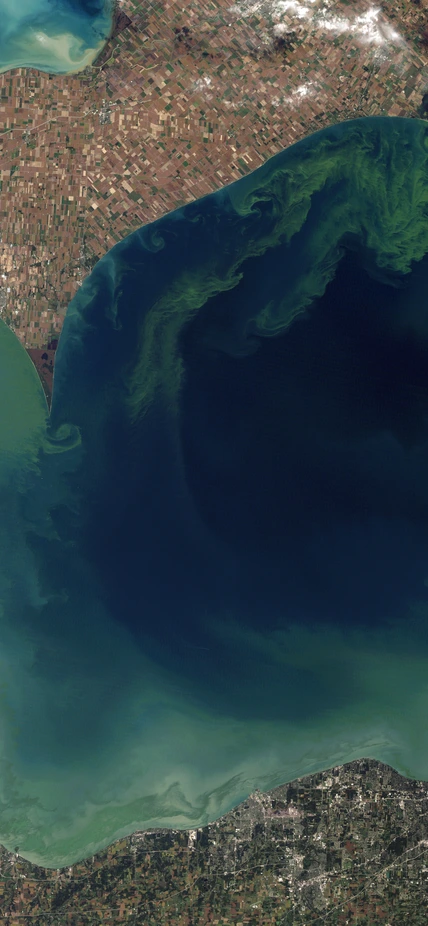Washington, D.C.—A research team, led by Carnegie’s Anna Michalak, has determined that the 2011 record-breaking algal bloom in Lake Erie was triggered by long-term agricultural practices coupled with extreme precipitation, followed by weak lake circulation and warm temperatures. The team also predicts that, unless agricultural policies change, the lake will continue to experience extreme blooms. The research was published in the Proceedings of the National Academy of Sciences.
“The perfect storm of weather events and agricultural practices that occurred in 2011 is unfortunately consistent with ongoing trends, which means that more huge algal blooms can be expected in the future unless a scientifically guided management plan is implemented for the region,” remarked Michalak.
Fresh water algal blooms can result when excessive amounts of phosphorus and nitrogen are added to the water, typically as runoff from fertilized agriculture. These excess nutrients encourage unusual growth of algae and aquatic plants. When the plants and algae die, the decomposers that feed on them use up oxygen, which can drop to levels too low for aquatic life to thrive. In the beginning, the Lake Erie algae were almost entirely Microcytsis, an organism that produces a liver toxin and can cause skin irritation.
The scientists combined sampling and satellite-based observations of the lake with computer simulations. The bloom began in the western region in mid-July and covered an area of 230 square miles (600 km2). At its peak in October, the bloom had expanded to over 1930 square miles (5000 km2). Its peak intensity was over 3 times greater than any other bloom on record.
The researchers looked at numerous factors that could have contributed to the bloom including land use, agricultural practices, runoff, wind, temperature, precipitation, and circulation.
The use of three agricultural nutrient management practices in the area can lead to increased nutrient runoff: autumn fertilization, broadcast fertilization, and reduced tillage. These practices have increased in the region over the last decade.
Conditions in the fall of 2010 were ideal for harvesting and preparing the fields, increasing fertilizer application for the spring planting. A series of strong storms the following spring caused large amounts of phosphorus to run off into the lake. In May alone rainfall was over 6.5 inches (170 mm), a level more than 75% above the prior 20-year average for the month. This onslaught resulted in among the largest observed spring phosphorus loads since 1975, when intensive monitoring began.
Lake Erie was not unusually calm and warm before the bloom. But after the bloom began, warmer water and weaker currents encouraged a more productive bloom than in prior years. The longer period of weak circulation and warmer temperatures helped incubate the bloom and allowed the Microcytsis to remain near the top of the water column. That had the added effect of preventing the nutrients from being flushed out of the system.
The researchers’ data did not support the idea that land-use and crop choices contributed to the increase in nutrient run-off that fueled the bloom.
To determine the likelihood of future mega-blooms, the scientists analyzed climate model simulations under both past and future climate conditions. They found that severe storms become more likely in the future, with a 50% increase in the frequency of precipitation events of.80 inch (20 mm) or more of rain. Stronger storms, with greater than 1.2 inch (30 mm) of rain, could be twice as frequent.
The authors believe that future calm conditions with weak lake circulation after bloom onset is also likely to continue since current trends show decreasing wind speeds across the U.S. This would result in longer lasting blooms and decreased mixing in the water column.
“Although future strong storms may be part of the new normal,” remarked Michalak. “Better management practices could be implemented to provide some relief to the problem.”
Top Image Caption: Aerial view of a toxic algae bloom in Lake Erie
___________________
This material is based upon work supported by the National Science Foundation Water Sustainability and Climate program under Grant No. 1039043, Extreme events impacts on water quality in the Great Lakes: Prediction and management of nutrient loading in a changing climate, see: http://www.miseagrant.umich.edu/nsfclimate. Additional support for some of the co-authors was provided by NSF grant 0927643, the NOAA Center for Sponsored Coastal Ocean Research grant NA07OAR432000, and Lake Erie Protection Fund #SG 406-2011.
The Department of Global Ecology was established in 2002 to help build the scientific foundations for a sustainable future. The department is located on the campus of Stanford University, but is an independent research organization funded by the Carnegie Institution. Its scientists conduct basic research on a wide range of large-scale environmental issues, including climate change, ocean acidification, biological invasions, and changes in biodiversity.
